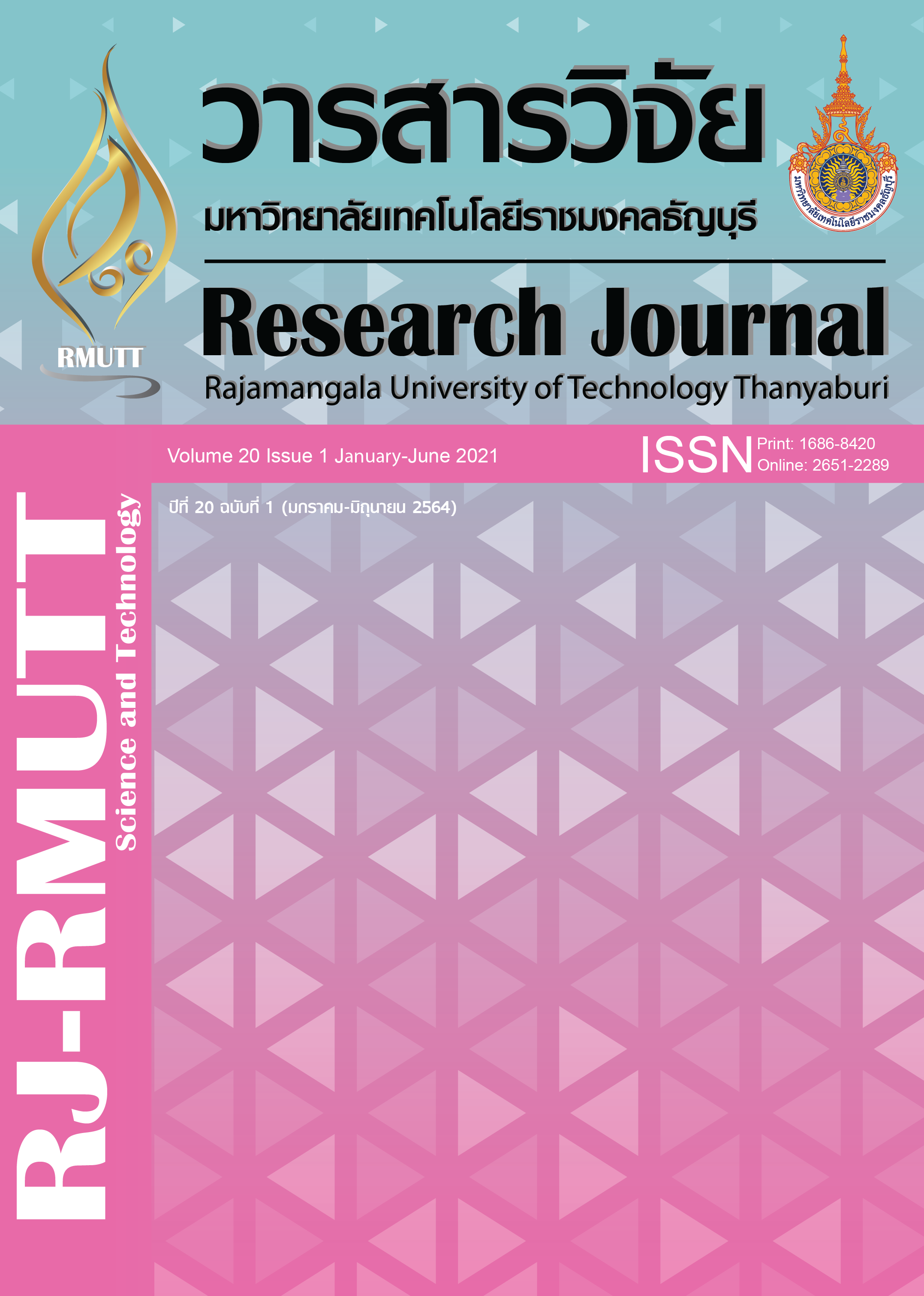Feasibility Study the Methane Production with Co-digestion between Napier grass in Degrade Land and Swine Manure
Main Article Content
Abstract
This research was feasibility study the methane production with co-digestion between Napier grass in degrade land and swine manure. The feasibility consideration was divided into 2 parts: methane production and economic feasibility. The degrade land is saline, acid, and compact soil. The ratio of co-digestion between Napier grass and swine manure was 1:2 and the conditions were controlled for methane production with completely mixed. This research found that the methane production from acid soil was effective with cumulative methane 9 liters, methane production potential 9,280 ml, and maximum methane production rate 872.20 ml h-1, in term of Napier grass in saline, and compact soil were 2,936.57 and 1,967.75, respectively. The maximum methane production rate from Napier grass in saline, and compact soil were 767.45, and 910.56 ml h-1, respectively. The consideration of feasibility study for the project was studied benefit / cost ratio (B/C ratio), net present value (NPV), internal rate return (IRR), and payback period (PBP). The research found that B/C ratio was more than 1, B/C ratio is the first of factor that can be considered economic feasibility. Payback period was less than 1 year. NPV and Internal rate return (IRR) of Napier grass in acid soil were 95,991.95 bath and 117%, respectively. These factors showed that this project is worth to investment for methane production in household.
Article Details

This work is licensed under a Creative Commons Attribution-NonCommercial-NoDerivatives 4.0 International License.
References
Chen H. Biotechnology of lignocellulose: Theory and Practice. 1st ed. Netherlands: Springer Netherlands; 2014.
วนัสพรรัศม์ สวัสดี, นิพนธ์ พิสุทธิ์ไพศาล. การทดสอบประสิทธิภาพการผลิตก๊าซชีวภาพจากหญ้าเนเปียร์ที่ปลูกในดินเค็ม ดินเปรี้ยว และดินดาน. กรุงเทพมหานคร: สำนักงานคณะกรรมการวิจัยแห่งชาติ (วช.); 2562. วช.04_2562.
กรรณิการ์ ชูเกียรติวัฒนา. จุลชีววิทยาสำหรับนักวิทยาศาสตร์และวิศวกรสิ่งแวดล้อม. พิมพ์ครั้งที่ 1. กรุงเทพมหานคร: สำนักพิมพ์แห่งจุฬาลงกรณ์มหาวิทยาลัย; 2561.
สันทัด ศิริอนันต์ไพบูลย์. ระบบบำบัดน้ำเสีย Wastewater Treatment System. พิมพ์ครั้งที่ 1. กรุงเทพมหานคร: สำนักพิมพ์ท้อป จำกัด; 2557.
Njogu P, Kinyua R, Muthoni P, Nemoto Y. Biogas production using water hyacinth (Eicchornia Crassipes) for electricity generation in Kenya. EPE Journal. 2015;7:209-16.
ฟาริดา พรหมมา, ดุษณี ธนะบริพัฒน์, ปราโมทย์ ศิริโรจน์. การผลิตก๊าซชีวภาพจากหญ้าเนเปียร์ 3 สายพันธุ์. วารสารวิทยาศาสตร์ลาดกระบัง. 2557;23(2):30-50.
Mansor AM, Lim JS, Ani FN, Hashim H, Ho WS. Characteristics of Cellulose, Hemicellulose and Lignin of MD2 Pineapple Biomass. CET Journal. 2019;72:79-84.
Sawasdee V, Pisutpaisal N. Economic Feasible Evaluation of Biogas Production from Napier Grass. Res J Biotech. 2015;10(3):94-8.
Sawasdee V, Haosagul S, Pisutpaisal N. Co-digestion of waste glycerol and glucose to enhance biogas production. Int J Hydrog Energy. 2019;44(56):29575-82.
Tjørve KMC, Tjørve E. The use of Gompertz models in growth analyses, and new Gompertz-model approach: An addition to the Unified-Richards family. PLOS one. 2017;12(6):1-17.
เยาวเรศ ทับพันธุ์. การประเมินโครงการตามแนวทางเศรษฐศาสตร์. พิมพ์ครั้งที่ 3. กรุงเทพมหานคร: สำนักพิมพ์มหาวิทยาลัยธรรมศาสตร์; 2551.
อลิศรา เรืองแสง. เชื้อเพลิงชีวภาพและชีวเคมีภัณฑ์โดยจุลินทรีย์. พิมพ์ครั้งที่ 1. ขอนแก่น: โรงพิมพ์มหาวิทยาลัยขอนแก่น; 2562.
สาวิตรี วทัญญูไพศาล. จุลชีววิทยาเบื้องต้น. พิมพ์ครั้งที่ 1. กรุงเทพฯ: ศูนย์ผลิตตำราเรียน มหาวิทยาลัยเทคโนโลยีพระจอมเกล้าพระนครเหนือ; 2552.
Nuansawan N, Sawasdee V. Biochemical Methane Potential from Leachate, Case study Sainoi, Nonthaburi Province. J Ind Tech. 2018;14(3):82-92.


